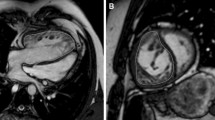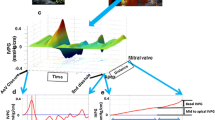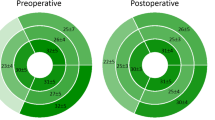Abstract
The aim of the study was to evaluate systemic right ventricular (RV) dyssynchrony in patients with congenitally corrected transposition of the great arteries (CCTGA) and transposition of the great arteries (TGA) with New York Heart Association functional class (NYHA FC) < III. We used cardiac magnetic resonance (CMR) to evaluate the dyssynchrony and assessed whether RV dyssynchrony can be predictive of major cardiac events in their early stages in these patients. We enrolled 71 consecutive, NYHA FC < III patients with systemic RV who underwent CMR between April 1995 and December 2016. We measured intra- and inter-ventricular dyssynchrony using a feature-tracking method of cine magnetic resonance imaging. The predictors of major cardiac events were analyzed using the Cox hazard analysis. The data from 36 patients with CCTGA and 35 patients with TGA after an atrial switch were analyzed. Seven (19.4%) patients with CCTGA and 6 (17.1%) patients with TGA showed a QRS duration of ≥ 130 ms. There were significant intra- and inter-dyssynchrony in the systemic RV groups, compared to healthy controls. The average follow-up period was 5.1 ± 3.9 years. From among patients with CCTGA, 9 (25.0%) had major cardiac events. The parameters including NYHA FC, indexed RV volume, longitudinal early diastolic strain rate, and intra- and inter-ventricular dyssynchrony were predictive of major cardiac events. From among patients with TGA, 12 (34.3%) had major cardiac events. Age, NYHA FC, QRS duration, RV volume, RV mass index, LV volume, global longitudinal/circumferential strain and intraventricular dyssynchrony, were all predictive of major cardiac events. Systemic RV in NYHA FC < III patients with CCTGA and TGA, have obvious intra- and inter-dyssynchrony, suggesting ineffective wall motion and potential RV dysfunction. Intraventricular dyssynchrony can be an adjunct predictor of major cardiac events in mildly symptomatic patients with both CCTGA and TGA.


Similar content being viewed by others
References
Piran S, Veldtman G, Siu S, Webb GD, Liu PP (2002) Heart failure and ventricular dysfunction in patients with single or systemic right ventricles. Circulation 105:1189–1194
Haddad F, Hunt SA, Rosenthal DN, Murphy DJ (2008) Right ventricular function in cardiovascular disease, part I: anatomy, physiology, aging, and functional assessment of the right ventricle. Circulation 117:1436–1448
Hauser M, Bengel FM, Hager A, Kuehn A, Nekolla SG, Kaemmerer H, Schwaiger M, Hess J (2003) Impaired myocardial blood flow and coronary flow reserve of the anatomical right systemic ventricle in patients with congenitally corrected transposition of the great arteries. Heart 89(10):1231–1235
Hauser M, Meierhofer C, Schwaiger M, Vogt M, Kaemmerer H, Kuehn A (2015) Myocardial blood flow in patients with transposition of the great arteries—risk factor for dysfunction of the morphologic systemic right ventricle late after atrial repair. Circ J 79(2):425–431
Yeo WT, Jarman JW, Li W, Gatzoulis MA, Wong T (2014) Adverse impact of chronic subpulmonary left ventricular pacing on systemic right ventricular function in patients with congenitally corrected transposition of the great arteries. Int J Cardiol 171(2):184–191
Hofferberth SC, Alexander ME, Mah DY, Bautista-Hernandez V, del Nido PJ, Fynn-Thompson F (2016) Impact of pacing on systemic ventricular function in L-transposition of the great arteries. J Thorac Cardiovasc Surg 151(1):131–138
van der Bom T, Winter MM, Groenink M, Vliegen HW, Pieper PG, van Dijk AP, Sieswerda GT, Roos-Hesselink JW, Zwinderman AH, Mulder BJ, Bouma BJ (2013) Right ventricular end-diastolic volume combined with peak systolic blood pressure during exercise identifies patients at risk for complications in adults with a systemic right ventricle. J Am Coll Cardiol 62(10):926–936
Diller GP, Radojevic J, Kempny A, Alonso-Gonzalez R, Emmanouil L, Orwat S, Swan L, Uebing A, Li W, Dimopoulos K, Gatzoulis MA, Baumgartner H (2012) Systemic right ventricular longitudinal strain is reduced in adults with transposition of the great arteries, relates to subpulmonary ventricular function, and predicts adverse clinical outcome. Am Heart J 163(5):859–866
Babu-Narayan SV, Prati D, Rydman R, Dimopoulos K, Diller GP, Uebing A, Henein MY, Kilner PJ, Gatzoulis MA, Li W (2016) Dyssynchrony and electromechanical delay are associated with focal fibrosis in the systemic right ventricle—insights from echocardiography. Int J Cardiol 220:382–388
Forsha D, Risum N, Smith PB, Kanter RJ, Samad Z, Barker P, Kisslo J (2016) Frequent activation delay-induced mechanical dyssynchrony and dysfunction in the systemic right ventricle. J Am Soc Echocardiogr 29(11):1074–1083
Plymen CM, Hughes ML, Picaut N, Panoulas VF, Macdonald ST, Cullen S, Deanfield JE, Walker F, Taylor AM, Lambiase PD, Bolger AP (2010) The relationship of systemic right ventricular function to ECG parameters and NT-proBNP levels in adults with transposition of the great arteries late after Senning or Mustard surgery. Heart 96:1569–1573
Tracy CM, Epstein AE, Darbar D, DiMarco JP, Dunbar SB, Estes NA 3rd, Ferguson TB Jr, Hammill SC, Karasik PE, Link MS, Marine JE, Schoenfeld MH, Shanker AJ, Silka MJ, Stevenson LW, Stevenson WG, Varosy PD, Ellenbogen KA, Freedman RA, Gettes LS, Gillinov AM, Gregoratos G, Hayes DL, Page RL, Stevenson LW, Sweeney MO, American College of Cardiology Foundation; American Heart Association Task Force on Practice Guidelines; Heart Rhythm Society (2012) 2012 ACCF/AHA/HRS focused update of the 2008 guidelines for device-based therapy of cardiac rhythm abnormalities: A report of the American College of Cardiology Foundation/American Heart Association Task Force on Practice Guidelines and the Heart Rhythm Society. Circulation 126:1784–1800
van der Hulst AE, Delgado V, Blom NA, van de Veire NR, Schalij MJ, Bax JJ, Roest AA, Holman ER (2011) Cardiac resynchronization therapy in paediatric and congenital heart disease patients. Eur Heart J 32(18):2236–2246
Janousek J, Gebauer RA, Abdul-Khaliq H, Turner M, Kornyei L, Grollmuss O, Rosenthal E, Villain E, Fruh A, Paul T, Blom NA, Happonen JM, Bauersfeld U, Jacobsen JR, van den Heuvel F, Delhaas T, Papagiannis J, Trigo C (2009) Cardiac resynchronization therapy in paediatric and congenital heart disease: differential effects in various anatomical and functional substrates. Heart 95:1165–1171
Bax JJ, Bleeker GB, Marwick TH, Molhoek SG, Boersma E, Steendijk P, van der Wall EE, Schalij MJ (2004) Left ventricular dyssynchrony predicts response and prognosis after cardiac resynchronization therapy. J Am Coll Cardiol 44:1834–1840
Van de Veire NR, Blom NA, Holman ER, Schalij MJ, Bax JJ (2007) Triplane tissue Doppler imaging to evaluate mechanical dyssynchrony before and after cardiac resynchronization in a patient with congenitally corrected transposition of the great arteries. J Cardiovasc Electrophysiol 18(2):222–225
Cazeau S, Bordachar P, Jauvert G, Lazarus A, Alonso C, Vandrell MC, Mugica J, Ritter P (2003) Echocardiographic modeling of cardiac dyssynchrony before and during multisite stimulation: a prospective study. Pacing Clin Electrophysiol 26:137–143
Hirschfeld S, Meyer R, Schwartz DC, Korfhagen J, Kaplan S (1975) Measurement of right and left ventricular systolic time intervals by echocardiography. Circulation 51:304–309
Ebeid MR, Ferrer PL, Robinson B, Weatherby N, Gebland H (1996) Doppler echocardiographic evaluation of pulmonary vascular resistance in children with congenital heart disease. J Am Soc Echocardiogr 9:822–831
Pettersen E, Helle-Valle T, Edvardsen T, Lindberg H, Smith HJ, Smevik B, Smiseth OA, Andersen K (2007) Contraction pattern of the systemic right ventricle shift from longitudinal to circumferential shortening and absent global ventricular torsion. J Am Coll Cardiol 49(25):2450–2456
Lewis M, Ginns J, Rosenbaum M (2014) Is systemic right ventricular function by cardiac MRI related to the degree of tricuspid regurgitation in congenitally corrected transposition of the great arteries? Int J Cardiol 174(3):586–589
Franzoso FD, Wohlmuth C, Greutmann M, Kellenberger CJ, Oxenius A, Voser EM, Valsangiacomo Buechel ER (2016) Atrial function after the atrial switch operation for transposition of the great arteries: comparison with arterial switch and normals by cardiovascular magnetic resonance. Congenit Heart Dis 11(5):426–436
Acknowledgements
We would like to thank Editage (http://www.editage.jp) for English language editing.
Author information
Authors and Affiliations
Corresponding author
Ethics declarations
Conflict of interest
The authors have no conflict of interest, financial or otherwise, related to this study.
Rights and permissions
About this article
Cite this article
Shiina, Y., Inai, K., Takahashi, T. et al. Inter- and intra-ventricular dyssynchrony in the systemic right ventricle is a surrogate marker of major cardiac events in mildly symptomatic patients. Heart Vessels 33, 1086–1093 (2018). https://doi.org/10.1007/s00380-018-1144-2
Received:
Accepted:
Published:
Issue Date:
DOI: https://doi.org/10.1007/s00380-018-1144-2




